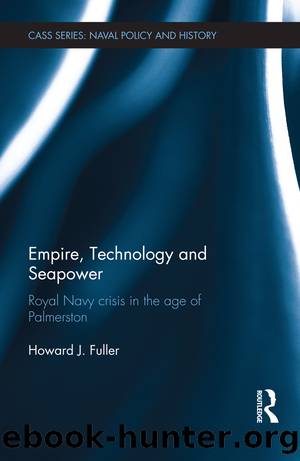Empire, Technology and Seapower by Howard J. Fuller

Author:Howard J. Fuller [Fuller, Howard J.]
Language: eng
Format: epub
Tags: History, Military, Naval, Europe, Great Britain, General, Modern, 19th Century
ISBN: 9781134200443
Google: 0kt_AgAAQBAJ
Publisher: Routledge
Published: 2014-01-03T01:21:41+00:00
19 âThe means by which we shall again be able to catch the bird in his own netâ
Perhaps the previous obsession with safely âout-rangingâ the Russian shore defences had blinded post-war British tacticians and early ironclad designers? Captain Fishbourne had been certain at the beginning of 1859 that the âprinciple of Armstrongâs gun is so correct, and the details of its carriage-slide and missiles so simple and complete, that it will be the work of but a short time to satisfy the most incredulous as to their great valueâ. Here their primacy lay in the ability âof throwing shot into embrasures, of hitting a narrow and definite line for breaching purposes, or of throwing shot into shipsâ ports, or of hitting them âbetween wind and waterâ â. Sitting in the audience that evening was Sir William himself, who could only concur âas to the importance of a steady platformâ.1 Two years later, and the Institution of Naval Architects was rife with debate on âIron-Cased Vessels of Warâ, in a two-day session chaired by Sir John Pakington. The first paper read, by General Sir Howard Douglas, was an âartillery-manâsâ response to the critiques made by iron shipbuilders with whom he had taken issue. In the pursuit of high speed, massive iron-hulled ships made themselves increasingly less practical men-of-war. Britainâs naval supremacy âmight possibly thus be tampered with by a speculative philosophy, which would prescribe to our descendants the mode and means of warfare for a remote futureâ. Renowned engineer and iron shipbuilder Joseph dâAguilar Samuda was glad that the new Hector and Valiant would finally see fully armoured British ironclads, âthe Admiralty having now recognized the deficiency of their original plan and started to correct it in the right, improvement may be looked for in each successive productionâ.2 J. Scott Russell, however, the famed builder of Brunelâs Great Eastern, followed this up by stressing that a âperfectâ ironclad (combining invincible strength, irresistible hitting power, high-speeds and steadiness) was physically impossible, âfor all shipbuilding is a matter of compromiseâ. The sailor could tell the engineer what he wanted in a warship. After that, hard choices had to be made. Russell at least considered the âdistinguished position in the new era of naval tactics and of naval construction which we now see before usâ as hinging on the real strength of the country: âits power of rapid productionâ. Yet while the volunteer corps and the armyâs drive for new coastal fortifications had demonstrated the British peopleâs resolve, âour supremacy on the sea which is vital to our national prosperity ⦠remains still in a condition to be questionedâ. This expression was significant; Britainâs success was maritime-based, and whereas the colonies or other imperial dominions might require local protection from attacks, overseas trade itself was both more valuable and vulnerable. The nation had âslumberedâ in its false belief in âwooden wallsâ when it should have been building more ironclads â more Warriors. Having a stake in her design, along with Pakingtonâs Admiralty, Russell hoped
Download
This site does not store any files on its server. We only index and link to content provided by other sites. Please contact the content providers to delete copyright contents if any and email us, we'll remove relevant links or contents immediately.
| Automotive | Engineering |
| Transportation |
Machine Learning at Scale with H2O by Gregory Keys | David Whiting(4261)
Never by Ken Follett(3885)
Urban Outlaw by Magnus Walker(3367)
OPNsense Beginner to Professional by Julio Cesar Bueno de Camargo(3262)
Sapiens and Homo Deus by Yuval Noah Harari(3033)
Will by Will Smith(2875)
A Short History of Nearly Everything by Bryson Bill(2666)
Hooked: A Dark, Contemporary Romance (Never After Series) by Emily McIntire(2528)
Rationality by Steven Pinker(2330)
Borders by unknow(2282)
The Becoming by Nora Roberts(2156)
Holy Bible (NIV) by Zondervan(2101)
HBR's 10 Must Reads 2022 by Harvard Business Review(1822)
A Short History of War by Jeremy Black(1818)
The One Percenter Encyclopedia by Bill Hayes(1811)
Freedom by Sonny Barger(1785)
Go Tell the Bees That I Am Gone by Diana Gabaldon(1733)
Five Ways to Fall by K.A. Tucker(1726)
Girls Auto Clinic Glove Box Guide by Patrice Banks(1710)
